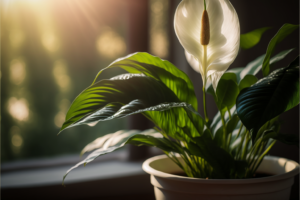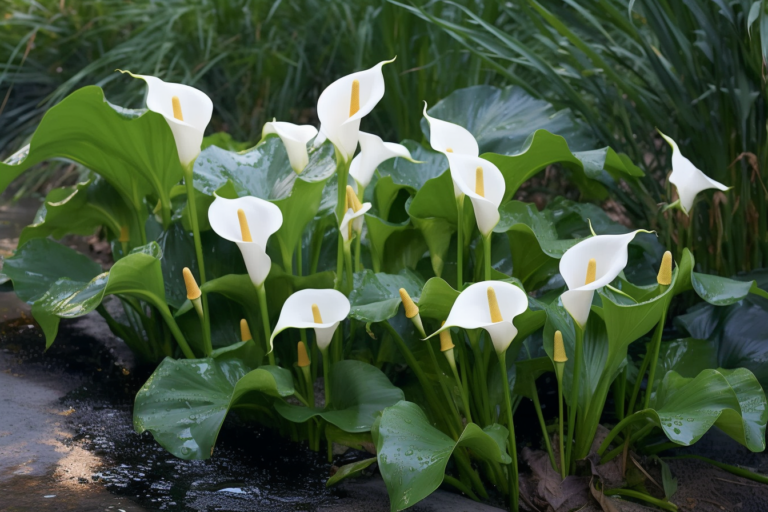We all adore the elegant and sophisticated calla lilies that grace our gardens with their trumpet-shaped flowers and lush green leaves. But how do we ensure these beauties thrive and flourish? A crucial aspect of calla lily care is understanding how often to water them. In this comprehensive guide, we’ll dive into everything you need to know about watering your calla lilies to ensure they remain healthy and vibrant.
Understanding Calla Lilies
Before we delve into watering specifics, it’s essential to understand the basics of calla lilies. These perennial plants belong to the Zantedeschia genus and are native to southern Africa. Calla lilies thrive in USDA zones 8-10 and prefer well-draining soil with a slightly acidic pH level.
The Importance of Proper Watering
Water is vital for calla lilies, as it helps them to absorb nutrients, maintain their structure, and carry out essential processes. Proper watering is crucial for the overall health and well-being of your plants.
When to Water Your Calla Lilies
It’s best to water your calla lilies early in the morning to give them enough time to absorb moisture before the sun’s heat evaporates it. Watering in the evening is also acceptable, but avoid late-night watering, as it can encourage fungal diseases.
How Much Water to Provide
When watering calla lilies, the general rule of thumb is to provide 1 inch of water per week. However, this can vary depending on several factors such as climate, soil type, and plant size. It’s essential to keep the soil consistently moist but not soggy.
Signs of Overwatering and Underwatering
Overwatering and underwatering can both harm your calla lilies. Here are some signs to watch out for:
- Overwatering: Yellowing leaves, root rot, and wilting despite wet soil.
- Underwatering: Wilted or curled leaves, stunted growth, and browning leaf tips.
Factors Affecting Watering Frequency
Several factors can influence how often you need to water your calla lilies:
- Climate: Hot and dry climates require more frequent watering, while cooler and more humid conditions demand less water.
- Soil type: Sandy soils drain quickly, necessitating more frequent watering, while clay soils retain moisture for longer periods, requiring less water.
- Plant size: Larger plants consume more water than smaller ones, so adjust your watering schedule accordingly.
- Sun exposure: Calla lilies in full sun need more water than those in partial shade.
Watering Calla Lilies in Containers
Calla lilies grown in containers require special attention regarding watering. Since containers have limited soil volume, they tend to dry out faster than in-ground plants. To keep your potted calla lilies healthy, check the soil moisture daily and water as needed to maintain consistent moisture.
Watering Calla Lilies During Dormancy
Calla lilies go dormant during the winter months. During this time, their watering needs decrease significantly. Reduce watering frequency and allow the soil to dry slightly between waterings to prevent root rot. Remember, however, not to let the soil dry out completely.
How to Water Calla Lilies
Proper watering is essential for the health and growth of Calla Lilies. Overwatering or underwatering can both have negative impacts on the plant, so it’s crucial to find the right balance. Here are some tips on how to water Calla Lilies:

- Check the soil: Before watering your Calla Lily, check the soil to make sure it’s dry. Insert your finger about an inch deep into the soil. If it feels moist, wait a few days before checking again. If it feels dry, it’s time to water your plant.
- Water thoroughly: When you water your Calla Lily, make sure to do so thoroughly. Water until it starts to drain out of the pot’s drainage holes. This will ensure that the whole root system is hydrated.
- Avoid getting water on the leaves: Calla Lilies are susceptible to fungal diseases, which can be exacerbated by getting water on the leaves. Water only the soil around the plant, not the leaves.
- Don’t let the plant sit in water: Make sure to discard any excess water that has collected in the drip tray underneath the pot. Allowing the plant to sit in stagnant water can lead to root rot.
- Adjust watering frequency according to environmental conditions: The frequency of watering your Calla Lily will depend on several factors, including the temperature, humidity, and light levels in your home. As a general rule, water your plant about once a week during the growing season and reduce watering during the dormant period.
By following these simple tips, you can help ensure that your Calla Lily thrives and produces stunning blooms.
Frequency of Watering Calla Lilies
Watering is an important aspect of plant care, especially when it comes to a sensitive plant like the Calla Lily. Watering frequency plays a crucial role in the growth and health of this plant. Here are some important points to keep in mind when considering how often to water Calla Lilies:
- Soil moisture: The soil should be moist but not water-logged. Overwatering can lead to root rot and other issues. The best way to ensure proper soil moisture is to check the top inch of soil. If it feels dry, it is time to water the plant.
- Weather conditions: The frequency of watering Calla Lilies also depends on the weather conditions. During hot and dry weather, water the plant more often to compensate for the loss of moisture through evaporation. In contrast, during cooler periods with less sunlight, the plant may require less water.
- Pot size: The size of the pot also affects the frequency of watering. Plants in smaller pots dry out faster and may need to be watered more often than those in larger pots.
- Drainage: Ensure the pot has good drainage to prevent water from accumulating at the bottom. Excess water can lead to root rot and other diseases.
In general, Calla Lilies should be watered once or twice a week during the growing season, with a reduced frequency during the dormant period. However, it is always important to keep a close eye on the soil moisture and adjust the watering schedule accordingly. Over time, you will become familiar with the needs of your plant and know exactly when it needs watering.
| Point | Frequency |
|---|---|
| Check soil moisture | Once a week |
| Water during hot and dry weather | More often |
| Water during cooler periods | Less often |
| Water plants in smaller pots | More often |
| Ensure good drainage | Always |
By following these tips, you can help ensure your Calla Lily receives the right amount of water, promoting healthy growth and a long lifespan.
When it comes to watering Calla Lilies, timing is key. As I discussed earlier, these plants prefer moist but well-drained soil, and over-watering can lead to root rot and other issues. However, under-watering can also be a problem, and it’s important to make sure your Calla Lilies are receiving enough water to thrive.
So, what is the best time of day to water Calla Lilies? In general, it’s a good idea to water them early in the morning. This allows the water to soak into the soil and be absorbed by the roots before any evaporation can occur. Watering in the evening isn’t necessarily a bad thing, but it can increase the risk of fungal disease if the leaves and flowers stay moist overnight.
Of course, the best time to water your Calla Lilies will depend on your schedule and the climate in your area. If you live in a hot, dry region, you may need to water them more frequently than if you live in a cooler, more humid climate. Pay attention to the soil and the appearance of the plant – if the soil feels dry or the leaves start to wilt, it’s time to water.
One thing to keep in mind is that Calla Lilies don’t like to sit in standing water, so it’s important to make sure the soil has good drainage. If you’re planting them in a pot, be sure to choose one with drainage holes and use a well-draining potting mix. If you’re planting them directly in the ground, add some sand or gravel to the soil to improve drainage.
Overall, watering Calla Lilies is all about finding the right balance. Too much water can be just as harmful as too little, so pay attention to the plant’s needs and adjust your watering schedule accordingly. By watering early in the morning and ensuring good drainage, you can help your Calla Lilies thrive and bloom beautifully.
Mistakes to Avoid When Watering Calla Lilies
Watering calla lilies can be troublesome if not done correctly. Overwatering, underwatering, and improper drainage can all cause issues for this elegant plant. To avoid making these mistakes, be sure to follow these tips:
- Overwatering: Calla lilies do not enjoy being in overly wet soil. Overwatering can lead to root rot and other fungal infections. A good way to test if the soil is too wet is to stick your finger about an inch into the soil. If it feels damp, hold off on watering until the soil dries out a bit.
- Underwatering: On the other side of the spectrum, underwatering can also cause issues for calla lilies. These plants should never be allowed to dry out completely. The best way to avoid underwatering is to check on your calla lilies regularly and water them when the top inch of soil is dry.
- Improper Drainage: Calla lilies should be planted in well-draining soil. If the soil they are in does not drain well, the roots can become waterlogged, leading to root rot. Make sure to plant your lilies in pots with drainage holes or in a well-draining garden bed.
- Watering Too Often: While calla lilies enjoy moist soil, they can become susceptible to root rot if they are watered too often. Be sure to let the soil dry out between waterings, and do not water more than once a week.
- Sprinkling Water from Above: It is best to water your calla lilies from below to avoid wetting the leaves. Wet foliage can attract pests and cause leaf rot. Set your potted lilies in a tray of water and let them soak up the water from below.
By following these tips, you can avoid common watering mistakes and ensure that your calla lilies thrive. Remember to test the soil moisture regularly and avoid overwatering.
Under this section, you can find several alternative ways to hydrate Calla Lilies which can be beneficial for their growth and blooming.
Alternative ways to hydrate Calla Lilies

- Misting Misting Calla Lilies is a great way to hydrate them without overwatering. Fill a spray bottle with clean water and gently mist the leaves and flowers on a regular basis. Avoid spraying water directly onto the soil as it may lead to fungal growth.
- Soaking the roots Soaking the roots of Calla Lilies is another alternative to watering them. Fill a container with water and submerge the pot in it for about an hour or until the soil is moist. Then, remove the pot from the water and let it drain. This can be an effective way to provide the necessary hydration without making the soil too muddy.
- Bottom watering Bottom watering is a good method to hydrate Calla Lilies as it allows them to absorb water from the bottom-up. Fill a tray with water and place the pot on top of it. Allow the soil to absorb as much water as it needs, then remove it from the tray. This prevents overwatering and keeps the plant healthy.
- Ice cubes Using ice cubes is an innovative way to water Calla Lilies. Place several ice cubes on top of the soil and let them melt, providing the plant with a slow and steady release of hydration. This method is particularly useful for those who tend to overwater their plants or live in areas with high humidity.
- Humidity trays Humidity trays are another alternative way to hydrate Calla Lilies by increasing the moisture level around the plant. Fill a tray with gravel or pebbles, then add water until it reaches just below the top of the rocks. Place the pot on the tray, making sure the bottom of the pot is not touching the water. The evaporation of the water will increase humidity levels, benefiting the plant.
By using these alternative methods to hydrate Calla Lilies, you can prevent issues like root rot or overwatering, leading to a healthier and more prospering plant.
Sure, thank you for the tip. Here’s the requested section on “Tips for maintaining healthy Calla Lilies”:
Tips for Maintaining Healthy Calla Lilies
As an expert in gardening, I understand the importance of proper care and maintenance for healthy plant growth. The same applies to calla lilies. Here are some essential tips to ensure your calla lilies thrive:
Choose the Right Soil
Calla lilies prefer loose, well-drained soil with plenty of organic material. Use a potting mix that contains peat moss, perlite, and vermiculite for optimal growth. The soil should also be slightly acidic, with a pH range of 6.0 to 6.5.
Water Sparingly
Overwatering can be detrimental to calla lilies. Water once a week or when the soil is dry to the touch. Avoid watering the leaves and instead pour water directly onto the soil. If the roots sit in water for too long, they may become waterlogged, causing root rot.
Provide Adequate Sunlight
Calla lilies require bright, indirect sunlight. Place them near a south-facing window or provide shade during the hottest part of the day. It’s essential to keep the plants away from direct sunlight, as this can cause their leaves to wilt or become scorched.
Fertilize Regularly
Calla lilies require a balanced fertilizer with an NPK ratio of 20-20-20. Apply fertilizer once a month during the growing season (spring and summer). Be careful not to over-fertilize as this can damage the plant.
Control Pests and Diseases
Calla lilies are susceptible to pests such as aphids, thrips, and spider mites. To prevent infestations, inspect your plants regularly and treat any signs of pests immediately. Use insecticidal soap or neem oil to control them. Also, ensure that the plant’s leaves and soil remain dry, as wet conditions can lead to fungal infections.
By following these tips, you can ensure your calla lilies stay in peak condition and bloom beautifully for years to come.
Common Mistakes to Avoid
When watering your calla lilies, avoid these common mistakes:
- Inconsistent watering: Calla lilies prefer consistently moist soil. Fluctuations in moisture levels can stress your plants.
- Using cold water: Cold water can shock your plants. Use room temperature water instead.
- Wet foliage: Water the base of your plants to prevent wetting the foliage, as this can promote fungal diseases.
- Calla lilies prefer consistently moist but not soaking wet soil.
- Water your calla lilies deeply, but infrequently.
- The frequency of watering will depend on factors such as the temperature, humidity, and soil type.
- In general, aim to water your calla lilies every 1-2 weeks.
- Always check the soil moisture level before watering.
Remember, overwatering can cause root rot and other issues, so be sure to err on the side of underwatering rather than overwatering. With these tips in mind, you should be able to keep your calla lilies looking healthy and vibrant.
FAQS
Do calla lilies need a lot of water?
Calla lilies require consistent moisture in the soil but not excessive amounts of water. Provide about 1 inch of water per week, adjusting for climate, soil type, and plant size.
Can calla lilies be overwatered?
Yes, overwatering can lead to yellowing leaves, root rot, and wilting. Ensure the soil is consistently moist but not soggy.
How can I tell if my calla lily needs water?
Check the soil moisture by sticking your finger about an inch into the soil. If it feels dry, it's time to water your calla lilies.
Should I water my calla lilies during dormancy?
During dormancy, reduce watering frequency and allow the soil to dry slightly between waterings. However, do not let the soil dry out completely.
Can I grow callalilies in containers?
Yes, calla lilies can be grown in containers, but they require special attention regarding watering. Check the soil moisture daily and water as needed to maintain consistent moisture.

